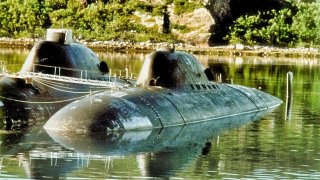Russia's Remarkable Titanium Submarines Brokes All the Records
Russia built several titanium submarines for its navy. While they were fast and dived to incredible depths, the U.S. Navy did not build such subs for clear reasons.
Why Russia Built Titanium Submarines - During the Cold War, the two great superpowers – the Soviets and the Americans – expended vast resources to match and surpass one another in terms of weaponry. Nothing spurs weapon development like an international rivalry (or open warfare), and the Cold War was billed as an epic confrontation. The two nations spent significant portions of their GDP to best the other. The result: increasingly agile fighter jets; bombers with higher payloads; stealth aircraft; intercontinental ballistic missiles; nuclear weapons with higher yields; satellites; lunar modules; more durable tanks; and so on.
Mostly, the two nations competed with one another head-to-head in an international game of one-upmanship. But in one realm, the Americans decided not to chase their Soviet counterparts: building a titanium submarine.
The Soviet Experiment with Titanium Submarines
In the 1960s, at the height of the Cold War, the Soviets began experimenting with the material to craft their submarines. Titanium had never been used to craft a submarine hull before. But the Soviets, appreciating the low density and high strength of titanium, opted to give the metal a try. The result was the Project 705 Lira.
The Lira entered the Soviet Navy in 1971 as one of the fastest submarines ever built. But the speed wasn’t the Lira’s most notable feature. Rather, the Lira’s most notable feature was the fact that titanium had been used to build the submarine’s hull.
The Lira submarine was designed around a specific set of requirements (which of course were set with the Americans in mind). The requirements included: the speed necessary to pursue any ship; low detectability; the ability to avoid anti-submarine weapons; minimal displacement; and as small a crew as possible. In other words, the Lira was designed to be fast, stealthy, maneuverable, and small; it was designed to best the Americans.
For the construction of the Lira’s hull, a special titanium alloy was used.
Why titanium? “Titanium alloy is usually stronger than steel but weighs half as [much],” Brett M. Eastwood wrote in these digital pages. “It is more expensive, up to three to five times more than steel. Titanium is also less corrosive in salt water. It can handle more pressure during deeper dives – all the way down to 2,200 feet.”
However, “fashioning titanium to make a hull is no easy feat. Welding is difficult and the slightest mistake during the welding phase could make the titanium brittle and less strong.”
In the original prototype design, the hull was small, weighing 1,500 tons, with low drag. Naturally, the small, low-drag hull was capable of reaching great speeds – in excess of 40 knots. Accordingly, the Lira would be used as an interceptor, mostly kept in harbors until needed to meet an enemy threat – at which point the Lira would be deployed to meet the enemy threat as quickly as possible.
But the prototype hull revealed itself to be impractical. A new design team was brought in and a more conventional hull was built. The new hull was 800 tons heavier but still featured the novel use of titanium.
The Lira “was state of the art in the 1960s,” Eastwood wrote. “It was going to reach speeds previously unattainable and be the quietest sub in the Russian navy. Titanium would be used for Lira hulls and a new lead-cooled reactor would power the ship to allow it to dive and turn quickly.” Able to reach 41 knots, “it could quickly attain that speed and adroitly switch directions when needed.”
For propulsion, the Lira used a lead-bismuth-cooled, beryllium-moderated reactor. The liquid metal-cooled reactor had multiple advantages over water-cooled reactors. For example, the energy efficiency was higher because the liquid metal reactor had a higher coolant temperature. The reactor could last an entire lifetime without needing to be refueled. The reactor was also safer, unable to explode, and able to solidify in the case of a leak. And lastly, the lead bismuth-cooled reactor was lighter and smaller than water-cooled reactors.
Yet, despite the advantages of the Lira, the U.S. chose not to compete with the Soviets in crafting a titanium-hulled submarine.

The Americans Defer
The Americans appreciated the benefits of the Lira’s titanium hull. Still, practical decisions were made, and restraint was practiced: the Americans chose not to build their own titanium-hulled submarine.
“The United States was aware of the power, speed, and stealth of the Lira-class and took a close look at the titanium construction,” Eastwood wrote. But “titanium is rare and costly compared to iron. Titanium is not easy to shape either.” Also, the margin of error for the welders making the hull was so small with titanium. “Any mis-step by the welders would create a sub that would be dangerous to take on deep dives.”

The Americans would have needed to create their own supply chain to source the titanium needed for the hull and “determined the effort and cost would not be worth it.”
About the Author
Harrison Kass is a defense and national security writer with over 1,000 total pieces on issues involving global affairs. An attorney, pilot, guitarist, and minor pro hockey player, Harrison joined the US Air Force as a Pilot Trainee but was medically discharged. Harrison holds a BA from Lake Forest College, a JD from the University of Oregon, and an MA from New York University. Harrison listens to Dokken.
All images are Creative Commons.


